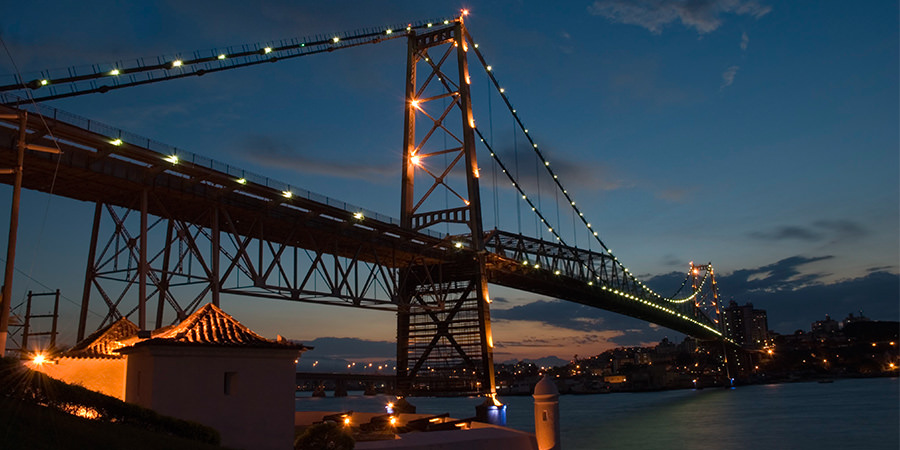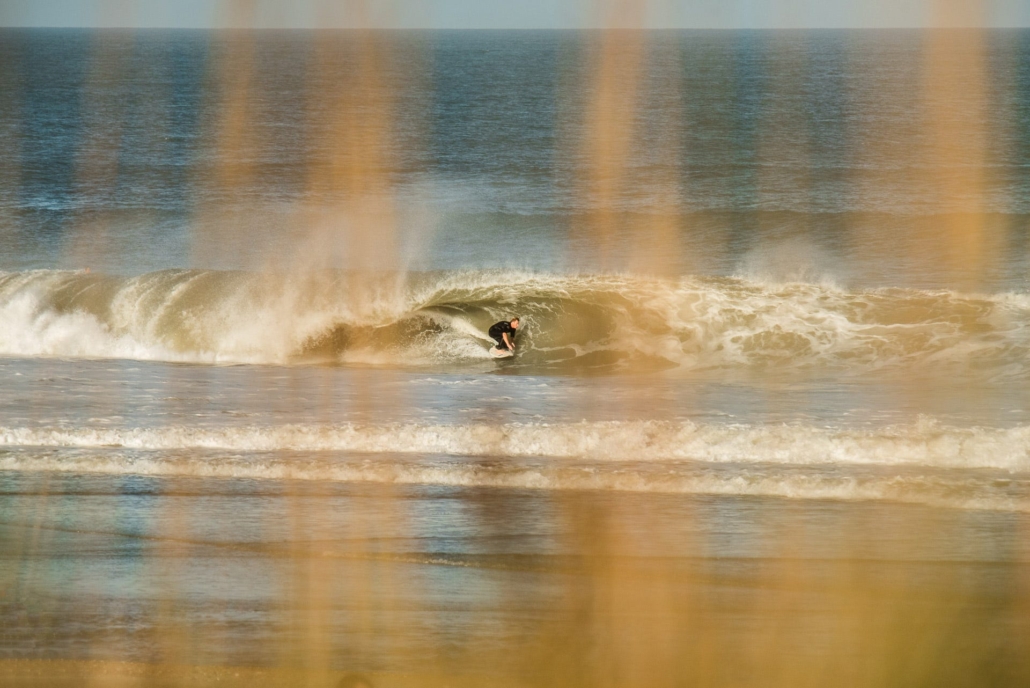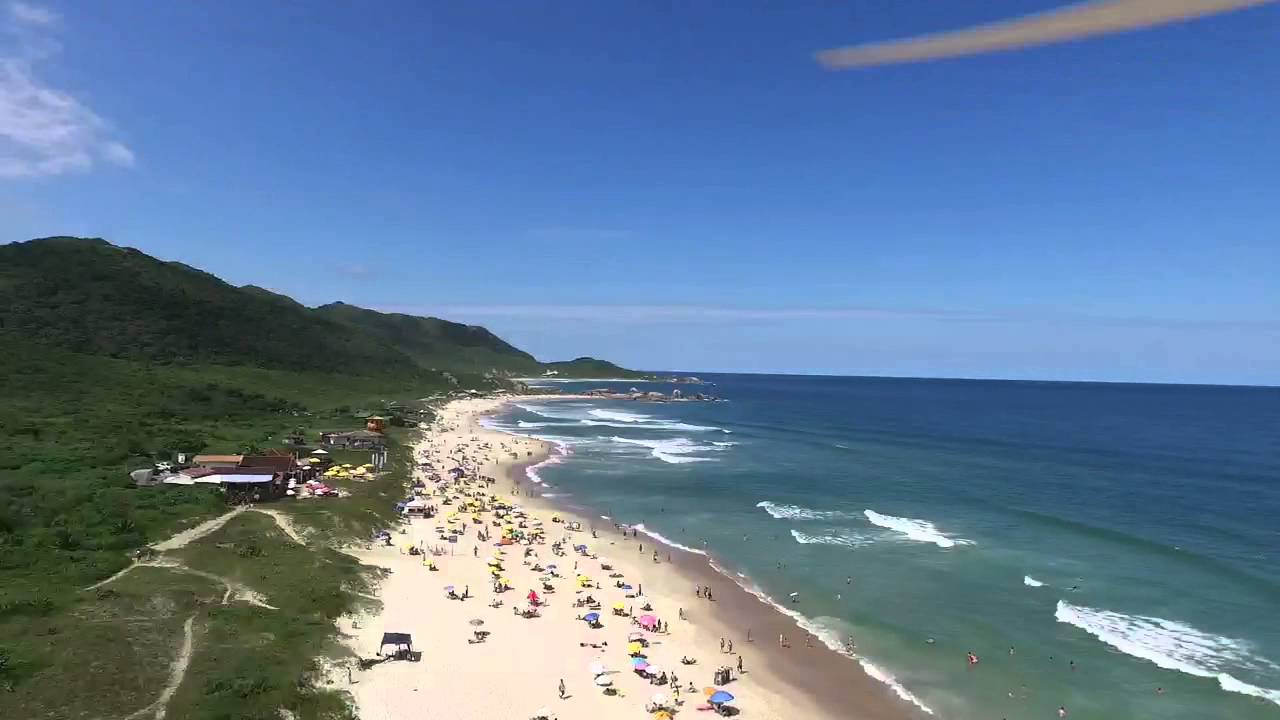Get to know Florianopolis
Many years before man existed paradise was already here. It is now called Florianópolis, and still maintains the same fascination that struck its first inhabitants and visitors. After the ocean covered all the valleys of the uneven land, twenty close-knit islands remained. Nature moved mountains of sand before uniting them to form Santa Catarina Island 20 million years ago. It was like painting a picture surrounded by the sea.
Several layers of sand were deposited between the islands like a brush passing on a painting, until a final sketch was defined. The details came afterwards.
Beaches, seashores, and swamps surrounded 172 km of borders. Trees with twisted bushes covered the sandy spaces with green. Two bays of quiet and warm waters separated island and continent.
Even a few mistakes contributed to the enrichment of the painter’s work. Some small and more distant islands were not covered with sand and remained around the large island, like pearls in a necklace. And it was by accident, like errant strokes of the brush, that two precious lakes were formed: Lagoa da Conceicão and Lagoa do Peri.
Santa Catarina Island is separated from the continent by a canal less than one km wide and 30 meters deep. It is the narrowest point between firm ground and the 431 square km surrounded by the sea, a piece of land running north-south, 54 km long and 19 km wide.
This land, parallel to the continent, inspired the Carijós Indians, its first inhabitants, to give the island the name of Meiembipe, which means “mountain along the canal.” The highest places in town coincide with the main islands from the united archipelago: the Ribeirão da Ilha Hill (south), 540 meters high, and the Ratones Hill (north), 525 meters high.
Certainly its natural resources attracted the first inhabitants to the island. Namely, its rich food offerings and peasant, mesoteric climate (temperatures between 3 and 40 C with annual average around 20 C).
Even the urban areas reveal treasures, like the Itacorubi Swamp and the forest around the Hospital de Caridade. In the past, the town had a larger area occupied by four swamps.
The Itacorubi Swamp is the most altered, and the swamp at Ratones is the most preserved; the one at Rio Tavares is the largest, and the one at Saco Grande is the smallest. The muddy land is the nursery, the protection and the food source for several animal species.
Ecosystem
Although the beaches are the most important tourist aspects in town, they are not the only options in Florianópolis. When travelling by car or by bus, one can encounter several pleasant surprises. If one considers the size of its territory, the island has tremendous biodiversity. What is most astonishing is the fact that everything is so close—the danger of putting its ecological treasures at risk is a reality.
What happened to the native forest is no different. The destruction of two types of vegetations – Litorânia and Atlantic Forest – contributed to the loss of the island’s original soil coverage.
On the smaller islands that surround the main island, much is still preserved. There are still 30 environments of Atlantic Forest and what is left from the Continental Platform. Arvoredo Island is the largest and is situated on a conversation area, together with Deserta Island. Campeche, to the south, can be easily visited, as well as the islands situated at the two bays: Anhatomirim, Ratones Grande, Ratones Pequeno, do Large, and das Flechas, among others.
What happened to the native forest is no different. The destruction of two types of vegetations – Litorânia and Atlantic Forest – contributed to the loss of the island’s original soil coverage.
On the smaller islands that surround the main island, much is still preserved. There are still 30 environments of Atlantic Forest and what is left from the Continental Platform. Arvoredo Island is the largest and is situated on a conversation area, together with Deserta Island. Campeche, to the south, can be easily visited, as well as the islands situated at the two bays: Anhatomirim, Ratones Grande, Ratones Pequeno, do Large, and das Flechas, among others.
The dunes make up another important ecological system that deserves care, because they originate the sandbanks. The dunes largest area is located between Lago da Conceicao and Joaquina Beach (east). It covers 5.6 square km, and is considered the geological model for environmental studies. Three different types of dunes can be found: fixed (or sandbanks), totally covered with vegetation; semi-fixed, partially covered with vegetation; and mobile, without vegetation. Several additional dunes appear among the primary dunes during the rainy season, and disappear when it stops raining. However, the preservation of the permanent lakes is what matters most to environmentalists.
History
From pre-history to today, much information about the settlement of Florianópolis has been lost. It is known that settlement occurred very slowly because the area was initially used only as a resting harbor for navigators travelling to the Rio da Prata region. For at least 4,500 years, the place was inhabited by Indians. It is not known when the Europeans arrived.
History books tell us that the discovery of the island was done from a distance, without landing, by the Portuguese explorer André Goncalves, in 1502, or by Goncalo Coelho, in 1503.
Portugal’s apathy towards their lands in southern Brazil led the Spanish to invest heavily in conquering the South Atlantic. In 1526 Sebastião Caboto arrived adn replaced the Portuguese name for Santa Catarina Island. Since then, and until the arrival of the colonial expedition of Francisco Dias Velho from São Paulo State in 1675, several fruitless colonization attempts were made.
Indian Inhabitants
Old inscriptions and “sambaquis” (piles of shells mixed with other objects) are signs of pre-historic life on Santa Catarina Island. They were probably left by nomads that passed through the island long before the first steady inhabitants, the Carijós Indians. On the coast of Campeche Island (south) are 73 of the more than 100 rocks marked with strange inscriptions and spread throughout the island. Among more than 50 sambaquis, the oldest one is about 4,500 years old and was found at Pântano do Sul Beach.
The origin of the Carijós Indians is a sad story. They may have descended from pre-historic people or may have migrated from the region that today is Paraguay. In the sixteenth century, they started to peacefully share what they had with the European travellers. They were hospitable Indians from the “Tupiguarani”nation, and used to live in villages of 30 to 80 houses supported by wood stakes and covered with palm tree leaves. They slashed canoes on “garapuvu” trees, and transformed rocks, clay, and vegetable fibers into useful tools.
However, during the sixteenth century the Europeans began to capture and enslave the Indians. When they were not sold as merchandise in São Vicente, São Paulo state, or in “Bahia de Todos os Santos”, they died of diseases brought over by the white man.
Foundation
The official settlement of Santa Catarina Island started in 1673. It began with the agricultural enterprise of Francisco Dias Velho, who sent one of his sons along with indians and “mamelucos” to the island. In 1675, he himself came from São Paulo to look after his business. He brought his wife, his other sons, an aggregated family, two priests from the “Companhia de Jesus,” and 500 more indoctrinated Indians. He built a chapel consecrated to “Our Lady of Desterro,” where the cathedral is found today.
In the fight to defend his land and his family, Dias Velho’s life came to a tragic end. Historians disagree about the year of his death (possibly 1687, 1688, or 1692). Some report that a Dutch ship coming from Peru with silver was attacked and defeated with guns and bullets by Dias Velho, who then kept the shipment. This version has the pirates returning a year later for retaliation, not only recovering their shipment but also killing Dias Velho and sexually abusing his three daughters. Perhaps as a result of this, the family of the founder and all their companions returned to São Paulo.
Colonization
After the tragic death of Dias Velho, the population of Santa Catarina Island decreased drastically. In the beginning of the seventeenth century, there were little more than 20 residents, most of them coming from São Francisco do Sul to occupy the regions of Our Lady of Necessities (Nossa Senhora das Necessidades) in Santo Antônio de Lisboa. Worrying about the extinction of their domain, in 1714 the Portuguese elevated Santa Catarina Island to the level of parish, naming it “Our Lady of Destoerro” (Nossa Senhora do Desterro”), after the existing chapel. In 1726, in another effort to rebuild the population started by Dias Velho, the parish was transformed into a municipal district.
The Immigrants From Açores
Constant earthquakes and the overpopulation of the Madeira Island and of the nine island that form the Archipelago of Acores stimulated the arrival of about 6,000 immigrants to the “Desterro” and to the Santa Catarina coast between 1747 and 1756. The immigration was part of Portugal’s political strategy to take over the American territory. Therefore, the transformation of the Santa Catarina Captaincy into a military center and operational base to occupy the southern part of Brazil was dependent on a sufficient population.
The first immigrants settled near the church, on a street adequately named “dos Ilhéus”. Inland, the first immigration village was founded in 1750 with two other parishes (São Miguel and Nossa Senhora do Posário da Enseada do Brito) and was named “Our Lady da Conceicaão da Lagoa” (Nossa Senhora da conceicão da Lagoa). In 1755, two more parishes were founded: “Nossa Senhora das Necessidades”, inland, and “Santo Antônio de Lisboa”, on the Island. Because ??entrance to the country was difficult??, the urban center developed near the continent.
In 1832, Desterro assumed the title of capital of Santa Catarina. The name was changed to Florianópolis in October, 1894. This controversial name, given in honor of Floriano Peixoto, is disliked by some inhabitants even today. To end the Federalist Revolution that attempted to depose him from the presidency, Floriano Peixoto ordered the execution of those revolutionaries considered enemies of the Republic. More than a hundred people were shot at Anhatomirim Island.
After the last naval battle in April, 1894, the capital of the state returned to the “Florianistas” domain (also named legalists). The victory against the federalists increased the prestige of the Santa Catarina republicans before the “Iron Marshal,” as Floriano Peixoto was known. In order to honor the marshal, the winners changed the name “Desterro” to his name, who ironically transformed the place into a death stage during the early years of the disturbed republic.
Defensive System
Worrying to keep the strategic domain over the island, the Portuguese Crown, in 1739, named as governor of the recently installed captaincy the Brigadier José da Silva Paes. His mission was to build many forts; to protect Desterro from Spanish invasions. The brigadier himself projected the first four forts. Three forts protected the entrance of the North Bay: Santa Cruz, São José da Ponta Grossa and Santo Antônio. The fort of Nossa Senhora da Conceição should not allow the entrance of intruders into the South Bay. Four other forts desappeared with time: São Luiz and São Francisco Xavier, on the North Sea Shore, São João, on the continent, and Nossa Senhora da Conceição, on the lake with the same name. The forts of Santana and Saint Barbaras still remain. Four of them were restored and are open for visitors. Together, they constitute the largest assemblage of forts in the country.
Spanish Invasion
The army ostented by the Portuguese was not strong enough to avoid the Spanish invasion of 1777. More than a hundred ships and 15.000 Spanish soldiers dominated the Island through the Canasvieiras bay. After sinking their ships the invaders took three days to domain the fort of São José da Ponta Grossa. After having cancelled the crossed opened fire defense system, the Spanish did not have problems to occupy Desterro, and after a war assembly, the Portuguese decided to give the Island to the enemy fleet captain. A year later they took over Desterro by the São Ildefonso Pact. In this pact the agreement was to return the place, considering that foreign ships would not be allowed to use the island as a base. The exclusivity belonged to Spanish ships.
Anhatomirim
The construction of the largest fort in southern Brazil, built first to protect Destorro, took five years. Santa Cruz was built on Anhoatormirim Island, at the entrance of the north bay, and was completed in 1744. Within its 2,678 square meters, 57 cannons were installed. After one and a half centuries, during the Federalist Revolution of 1894, political opponents of Floriano Peixoto were commonly arrested or executed here.
After the times of terror and reform passed, the rare beauty of the captain’s two-story colonial house remained. This house, delimited by majestic portico and characterized by its oriental design, served as the gunpowder and the troops’ headquarters. Lime and wood, as well as marble brought from Portugal, were used in the construction. Currently Santa Cruz de Anhatomirim is under the care of Universidade Federal de Santa Catarina (UFSC). There are a number of ways to visit the fort. You can rent a boat in the north beaches or take a schooner that leaves from either the north shore bay piers or from under Hercilio Luz Bridge. Visiting hours can be obtained at the Support Extension Department at UFSC by calling 331-9344.
Tourism
Tourism, a fundamental activity in the summer, generates millions of Reais in the city each year. The industrial sector focuses on civil construction, editorial and graphic areas, and in the manufacture of electric, electronic, and communication goods.
The current growth of the electric, electronic, computer, and communication industries was stimulated in 1991, when the governor created the computing area in Saco Grande district. These non-polluting activities have little negative impact on the environment.
The informal work market has grown in Florianópolis as it has around the rest of Brazil. It is comprised of the street market workers that populate the streets of the city all year round and by those who take advantage of the tourism during the summer. This includes the street peddlers, the homeowners who rent their houses and apartments, and the people who spend the day on the beach waiting for those who want to have a ride on jet skis, canoes, banana boats, bikes, schooners or sandboards.
Fishing
Even though the fishing sector has only a minor impact on the economy of the city, it a very important activity from a social standpoint. It includes the individual fishermen that are losing space in the market due to both the growth of industrial fishing and to their own gradual extinction as new generations are choosing other activities. To overcome the crisis, many fishermen have dedicated themselves to the breeding of oysters and mussels in a partnership with the Breeding Laboratory of Shellfish of UFSC. Selling their products mainly in the local market, these breeders are located in the communities of Santo Antonio de Lisboa and Sambaqui (north bay) and Ribeirão da II, Costeira do Ribeirão and Caieira da Barra Sul (South Bay).



